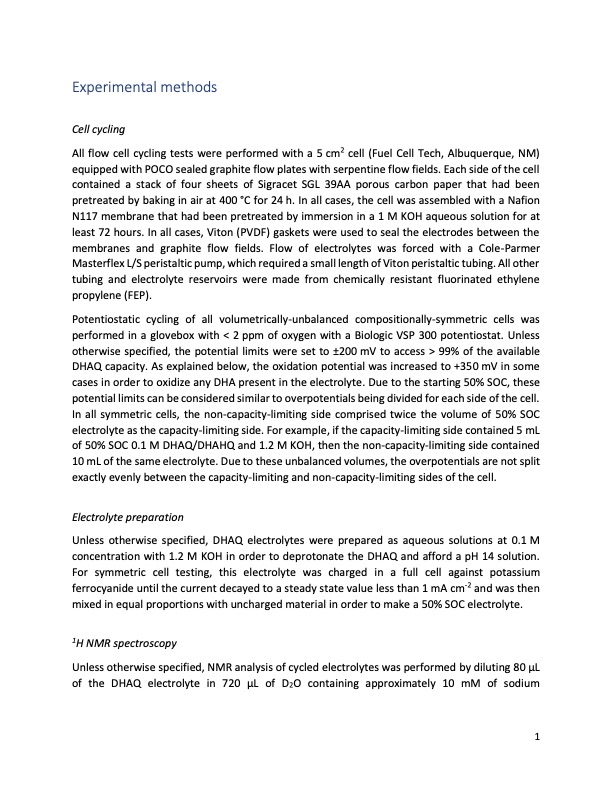
PDF Publication Title:
Text from PDF Page: 011
Experimental methods Cell cycling All flow cell cycling tests were performed with a 5 cm2 cell (Fuel Cell Tech, Albuquerque, NM) equipped with POCO sealed graphite flow plates with serpentine flow fields. Each side of the cell contained a stack of four sheets of Sigracet SGL 39AA porous carbon paper that had been pretreated by baking in air at 400 °C for 24 h. In all cases, the cell was assembled with a Nafion N117 membrane that had been pretreated by immersion in a 1 M KOH aqueous solution for at least 72 hours. In all cases, Viton (PVDF) gaskets were used to seal the electrodes between the membranes and graphite flow fields. Flow of electrolytes was forced with a Cole-Parmer Masterflex L/S peristaltic pump, which required a small length of Viton peristaltic tubing. All other tubing and electrolyte reservoirs were made from chemically resistant fluorinated ethylene propylene (FEP). Potentiostatic cycling of all volumetrically-unbalanced compositionally-symmetric cells was performed in a glovebox with < 2 ppm of oxygen with a Biologic VSP 300 potentiostat. Unless otherwise specified, the potential limits were set to ±200 mV to access > 99% of the available DHAQ capacity. As explained below, the oxidation potential was increased to +350 mV in some cases in order to oxidize any DHA present in the electrolyte. Due to the starting 50% SOC, these potential limits can be considered similar to overpotentials being divided for each side of the cell. In all symmetric cells, the non-capacity-limiting side comprised twice the volume of 50% SOC electrolyte as the capacity-limiting side. For example, if the capacity-limiting side contained 5 mL of 50% SOC 0.1 M DHAQ/DHAHQ and 1.2 M KOH, then the non-capacity-limiting side contained 10 mL of the same electrolyte. Due to these unbalanced volumes, the overpotentials are not split exactly evenly between the capacity-limiting and non-capacity-limiting sides of the cell. Electrolyte preparation Unless otherwise specified, DHAQ electrolytes were prepared as aqueous solutions at 0.1 M concentration with 1.2 M KOH in order to deprotonate the DHAQ and afford a pH 14 solution. For symmetric cell testing, this electrolyte was charged in a full cell against potassium ferrocyanide until the current decayed to a steady state value less than 1 mA cm-2 and was then mixed in equal proportions with uncharged material in order to make a 50% SOC electrolyte. 1H NMR spectroscopy Unless otherwise specified, NMR analysis of cycled electrolytes was performed by diluting 80 μL of the DHAQ electrolyte in 720 μL of D2O containing approximately 10 mM of sodium 1PDF Image | Extending organic flow batteries via redox state management

PDF Search Title:
Extending organic flow batteries via redox state managementOriginal File Name Searched:
mja287.pdfDIY PDF Search: Google It | Yahoo | Bing
Salgenx Redox Flow Battery Technology: Salt water flow battery technology with low cost and great energy density that can be used for power storage and thermal storage. Let us de-risk your production using our license. Our aqueous flow battery is less cost than Tesla Megapack and available faster. Redox flow battery. No membrane needed like with Vanadium, or Bromine. Salgenx flow battery
| CONTACT TEL: 608-238-6001 Email: greg@salgenx.com | RSS | AMP |